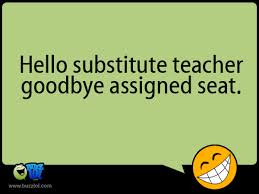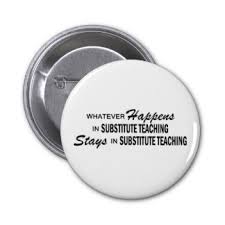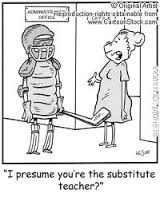It’s that time, again, when students and adults go back to school. Here’s a report from the point of view of the itinerant substitute teacher in secondary schools in northern California. How much of this story (the “good” and the “bad”) might be true in schools where you live?
Education in the Trenches: My Life as a Substitute Teacher
by D.G. Mitchell
image from writemejenb110.wordpress.com
It’s 5:30 AM when I get my first call for a substitute teaching assignment. A robotic voice tells me “This is the XYZ School District” and instructs me to push “1” if I am interested in a job. I’m only half-awake, but I dutifully push “1” and hear the description of a job at one of the local secondary schools.
PE teacher/wood shop. No, thanks. I press another number, telling them, “I can’t take this job, but call me back if you have another.”
Then, I go back to bed. At 8 AM, I’m having breakfast when the robot calls me again. They need an English teacher at another school. Of course, school has already started, but it was an emergency. They’re also getting a little desperate. So I take the job, rushing to get dressed and get out the door, travel mug in hand.
For about two years, I have had this routine, working as a substitute teacher in several school districts in Northern California . Many jobs are listed online, so one can avoid the early wake up call if one finds an assignment the night before. But, I am never quick enough: those jobs get snapped up in a hurry. More often than not, I get the wake-up call. Not knowing if I’ll be working until early each school day is nerve-wracking, but I am glad for the work.
Walking into a new class for the first time is something I never get used to. Years ago, I taught full-time in a junior high school in San Francisco, so I’m not new to teaching. Now, being in semi-retirement, I can always use the extra money, which is why I signed up as a “sub.” I didn’t realize how different “subbing” is from regular, full-time teaching. It’s also not very easy. Some teachers tell me they would never consider doing it.
It was many years ago that I was a full time teacher. A lot of things have changed.
Computer technology is one of the biggest and arguably more positive changes. Standardized testing is another, not so positive. A relaxation of discipline in the classroom, a lowering of expectations, gang violence on and off the streets: these are all definite negatives. It’s a very different world these days.
Let me describe my worst teaching day as a sub. After that, I will try to balance your understanding of my experiences by presenting one of my best days.
I believe that if one maintains a professional attitude, good days can make up for bad ones. See if you agree.
And just to be fair, I won’t mention any specific schools or teachers. I do think some of these observations apply to all schools at one time or another.
Interestingly, my worst-day experience occurred at one of the “better” high schools in the North Bay. I arrived on time, got handed a key and a folder, and tried to figure out where the classroom was before the bell rang. When I plan it right, I have time to review the lesson plans, scope out the classroom, and act as if I know what I’m doing when the kids come pouring in.
image from doug-johnson.squarespace.com
And they did come pouring in, loud and boisterous, nearly oblivious to my presence as the substitute teacher. When the bell rang, they all but ignored the fact that I was standing there, waiting for the class to settle down. It was First Period. Many of the kids came in with their heavy backpacks, hoodies and hats, holding their cell phones and their breakfasts.
My first request to them was to quiet down so that I could take attendance. That was routinely ignored. So I announced again, much louder, that if I called a name and did not get a response, that person would be marked absent. That request almost worked. But many of the kids had ear buds in their ears, listening to music or the radio, so they still did not hear me. And, they continued eating their breakfasts and texting on their cell phones.
I asked: “Are food and drink allowed in this classroom?” I got what is by now a familiar response: “Our teacher lets us do it.”
I was disgusted. There was food everywhere. It was very hard to maintain some kind of order while kids were eating, texting, or plugging their ears with ear buds and listening to music.
It’s hard to believe a teacher actually allows all this, but unfortunately in many high schools, this turns out to be true more often than not. But that wasn’t the end of the problems.
The school announcements came on, beginning with the Pledge of Allegiance. To my dismay, I noticed that fewer than half the class did not bother to stand up for the Pledge. Worse, those that were standing did not say the Pledge or even mouth the words. Most of the kids stayed in their seats, not even bothering to remove their hats or their hoodies.
I wouldn’t have thought this would bother me, but it actually upset me. Maybe because I’m considerably older than these kids and older than many of their teachers, I can’t help recalling another era, when it was unthinkable to show such disrespect for the flag. Maybe I’m showing my age here, but that “other” era was when I was in high school, in the early 60s. As I said before, a lot of things have changed since then.
At this point, I decided to attempt to utilize what is called a “teachable moment.” I temporarily turned away from the lesson plan the regular teacher had provided. Instead, I asked the class: “Why do so many of you refuse to stand up for the Pledge?”
image from ontheculture.com
I got a variety of sneers and laughs, but I saw that they were actually thinking about this. So, I pressed on.
Becoming the patriot that I never thought I was, I asked: “Do any of you have family members or friends in the military?” I saw many nodding and some raised their hands.
I chose to follow that question by reminding them that, at this very moment, “Some of your family and friends might be risking their lives for that flag. Did you think about that during the Pledge?”
It suddenly became very quiet. I think I made my point. I could have gone further, ignored the lesson plan and insisted on a short essay on a topic like: “What does the flag mean to you?” But then that “teachable moment” was interrupted when someone got a phone call, two kids got into a fight, and, inexplicably, one kid got up and left the room, never to return.
It was going to be a very long day.
With great persistence, I returned to the lesson plan. I should mention that I was fortunate to have been given a good lesson plan. Sometimes, I get just a brief description of what the class is doing, or maybe I get lucky and I can show some videos. At times, I am without a lesson plan or even a seating chart, so I’m completely on my own. In the schools that observe a “block” schedule, where the basic period length is just under two hours, this lack of direction from the absent teacher can create total chaos for a sub.
Meanwhile, back in the class, I had kids read aloud and answer some written questions. It took a while to get kids to read and to make sure the rest of the class could hear the reader. To a casual observer, it looked and sounded totally chaotic, with the food and garbage, the ear buds, and the low clamor of side discussions. But, in fact, the kids were actually doing the assignment.
However, about 45 minutes into the hour, two girls suddenly walked into the class, ignored my questions (“Who are you? Why are you 45 minutes late?”) and simply sat down as if I didn’t even exist. I was appalled at their disrespect. I asked that they leave to get a note from the office explaining their lateness. They stormed out, calling me some horrible names as they exited.
We tried to return to the assignment.
About 20 minutes later, those two girls returned, with the Assistant Principal. I usually never meet the administrators of a school, so I had to admit I had no idea who this person was nor why these girls were returning.
The Assistant Principal told me to admit them. I requested a private conference with this administrator, outside the door. We stepped into the hall where I explained how these girls had been belligerent to me, called me names, refusing to acknowledge me as a teacher. And, “By the way,” I asked, “why is it OK for these kids to have all their garbage all over the floor in this classroom? Is this typical?”
Unfortunately, the administrator did not see this as a problem. She informed me: “Each teacher can make their own rules for their classroom.”
I pointed out that my Substitute Handbook explicitly stated that there should be “no food or drink in the classroom.” I inquired, “Why is this not enforced?”
She dismissed the whole thing, again saying it was “up to the teacher.”
image from http://www.docstoc.com
Not the administration? Doesn’t it work from the top down? I kept those questions to myself, as the Assistant Principal did a quick about-face and walked back to her office.
I re-entered the classroom. That class ended soon after. I collected the papers and the kids left the room, as boisterously as they had entered it. There was a short break, when kids could go out and get snacks (which, of course, students brought back into the classroom the next period).
Things went from bad to worse as the day wore on. The next period was just as bad as the first. Fighting a losing battle with distractions from the food, drinks, cell phones and ear buds, I could not get them to even look at the assignment. I tried to intervene in another very loud and vulgar verbal battle. It could only be resolved by my referring one of the proponents to the Assistant Principal, presumably for detention.
That student also yelled at me as he was leaving, calling me a “faggot” (among other things). At that point, I really started to come apart. I admit, I used some inappropriate language myself to get him out of the classroom. This was not very wise, as I later found out. It was a little better to get him out of the class, but not much was accomplished. In fact, nothing at all. Apparently, the class sided with the disruptive kid so they refused to cooperate with anything I asked them to do after I ejected him
After lunch, as I was preparing for my last class, I had a visit from another administrator, who turned out to be the school’s Principal. She said: “We need to talk.” Those were fighting words; never a good thing.
She arranged for another sub to watch my class so that we could go to an empty classroom. We had a rather uncomfortable discussion. Justifiably, she was appalled that I had used a four-letter word while kicking out the unruly student. Of course, I had been listening to four-letter words all morning, but that was irrelevant. I had to plead guilty.
But, I also recounted some of the “highlights” of my morning, trying to explain to her, based on my having subbed in so many schools in this district, just why this particular school was the most unruly, slovenly and disrespectful (to the teachers, to the flag, to education).
Needless to say, she did not take my criticism of “her” school very well, particularly on the heels of my unprofessional behavior. She told me not to come back to her school. End of discussion.
image from http://www.zazzle.com.au
Thinking I was through as a substitute teacher, I was surprised to continue to get calls from other schools. Luckily, I returned to several junior high/middle schools that I had particularly liked. Since my original teaching experience in San Francisco had been with that age group, I noticed that I was a lot more comfortable with the younger kids.
Middle school kids seemed to have much less “attitude” than the high school students, and they were basically fun to be around. Not that eighth graders can’t also be a handful (raging hormones, etc), but I never took it personally. Bonus: since my original credential was in English, with these gigs, I enjoyed a lot of very fun assignments, teaching poetry, writing in journals, showing movies.
One of my best teaching days was in an eighth-grade English class at a middle school, where kids were expected to work in teams and come up with an original poem by the end of the period. As a former English teacher, I found this to be the perfect assignment. I had them read a few poems to get started, then talked about rhyme schemes and “scanning” a line. This was something new to them, so they actually showed a lot of interest, especially when I threw out some long technical words, like Iambic Pentameter and Anapestic, and challenged them to come up with some lines in those meters (my own favorite, and my alma mater, The University of Michigan, is a perfect line of Iambic Pentameter; I shared that with the class, as we all recited the familiar rhythm.
Typical eighth-graders, they tried to best and put down each other, occasionally getting a little silly or risqué, but actually enjoying the assignment. They were actually writing poetry. By the end of the period, each team was challenging each other, shouting their lines across the room.
image from info.marygrove.edu
Collecting their papers, I felt that they had really learned something and had fun at the same time. I felt validated as a teacher who instructed, not just filling time as another “sub.” On top of that, the school Principal actually came in to see what was going on and gave me a “thumbs up.” That made my day!
Good teaching days are few and far between, as every teacher knows. As a sub, they are even fewer. Returning to the same school and getting to know the kids better each time certainly helps. Getting support from other teachers and administrators also helps. Though I had one bad experience in one particular high school, I had enough good experiences in some of the middle schools to encourage me to continue subbing.
I’ve learned that there are certain things I simply cannot change. Cell phones, texting, electronic devices, computers are here to stay and I have to get used to them. Some teachers will insist that these items stay in the backpacks. As a sub, I don’t always have the authority to make such a rule, but it’s nice to see that some teachers have already instituted it. Food and drink will continue to bother me, as will the ear buds, baggy pants, hoodies, tattoos, and so much more of the current teen culture that I don’t fully understand. But I’m working on it.
It all starts up again in mid-August when the schools resume.
image from miracleon32ndstreet.wordpress.com
I’ll be watching my computer screen to avoid that 5:30 AM wake-up call. And I hope to be seeing some kids that I already know, finding out how they’ve changed over the summer. I always have a hopeful feeling at the beginning of the school year. Maybe this one will be a lot better.








You must be logged in to post a comment.